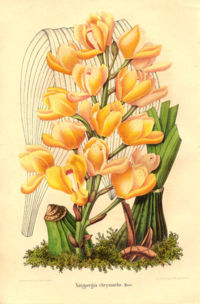Acineta: Difference between revisions
No edit summary |
No edit summary |
||
| Line 1: | Line 1: | ||
{{Inc| | |||
Acineta (immovable, referring to the jointless lip). Orchidaceae. Epiphytic hothouse orchids. | |||
Pseudobulbs conic or ovate, with the large plicate-veined lvs. articulated to the summit: fls. fleshy, borne in pendulous racemes on lateral leafless scapes; sepals broad, equal, finally somewhat spreading; petals similar to the sepals but smaller; lip fleshy, continuous with the base of the column, the middle lobe continuous or articulated, entire or 3-lobed; pollinia 2.—About 10 species, distributed from Mex. to northern S. Amer. | |||
These plants require a warm house and plenty of moisture during the growing season, with a decided rest, to make them flower. They need to be cultivated in wooden baskets and suspended from the roof of the house, as the flower-spikes are always produced from the base of the bulbs and there should be no hindrance in the way of crocks to prevent their egress. The rooting material may be peat fiber only, and not a great quantity under the plants, but plenty around them. With basket culture of orchids, it is very necessary, once a week in the growing season, to take the plants down and give a soaking by immersion, in addition to the ordinary spraying overhead from day to day; in this way alone can one be sure of the proper growing conditions. In winter, much less water is required. Propagation is by division of the plants in spring. (Orpet.) | |||
}} | |||
{{Taxobox | {{Taxobox | ||
| color = lightgreen | | color = lightgreen | ||
Revision as of 08:56, 22 June 2009
| Standard Cyclopedia of Horticulture |
|---|
|
Acineta (immovable, referring to the jointless lip). Orchidaceae. Epiphytic hothouse orchids. Pseudobulbs conic or ovate, with the large plicate-veined lvs. articulated to the summit: fls. fleshy, borne in pendulous racemes on lateral leafless scapes; sepals broad, equal, finally somewhat spreading; petals similar to the sepals but smaller; lip fleshy, continuous with the base of the column, the middle lobe continuous or articulated, entire or 3-lobed; pollinia 2.—About 10 species, distributed from Mex. to northern S. Amer. These plants require a warm house and plenty of moisture during the growing season, with a decided rest, to make them flower. They need to be cultivated in wooden baskets and suspended from the roof of the house, as the flower-spikes are always produced from the base of the bulbs and there should be no hindrance in the way of crocks to prevent their egress. The rooting material may be peat fiber only, and not a great quantity under the plants, but plenty around them. With basket culture of orchids, it is very necessary, once a week in the growing season, to take the plants down and give a soaking by immersion, in addition to the ordinary spraying overhead from day to day; in this way alone can one be sure of the proper growing conditions. In winter, much less water is required. Propagation is by division of the plants in spring. (Orpet.)
|
| Orchid genus Acineta {{{status}}} Fossil range: {{{fossil_range}}}
| ||||||||||||||||||||||||||||||||||||||||||||||||||||||||||||||||||
|---|---|---|---|---|---|---|---|---|---|---|---|---|---|---|---|---|---|---|---|---|---|---|---|---|---|---|---|---|---|---|---|---|---|---|---|---|---|---|---|---|---|---|---|---|---|---|---|---|---|---|---|---|---|---|---|---|---|---|---|---|---|---|---|---|---|---|
 Acineta chrysantha | ||||||||||||||||||||||||||||||||||||||||||||||||||||||||||||||||||
| Plant Info | ||||||||||||||||||||||||||||||||||||||||||||||||||||||||||||||||||
| ||||||||||||||||||||||||||||||||||||||||||||||||||||||||||||||||||
| Scientific classification | ||||||||||||||||||||||||||||||||||||||||||||||||||||||||||||||||||
| ||||||||||||||||||||||||||||||||||||||||||||||||||||||||||||||||||
| [[{{{diversity_link}}}|Diversity]] | ||||||||||||||||||||||||||||||||||||||||||||||||||||||||||||||||||
| {{{diversity}}} | ||||||||||||||||||||||||||||||||||||||||||||||||||||||||||||||||||
| Binomial name | ||||||||||||||||||||||||||||||||||||||||||||||||||||||||||||||||||
| {{{binomial}}} | ||||||||||||||||||||||||||||||||||||||||||||||||||||||||||||||||||
| Trinomial name | ||||||||||||||||||||||||||||||||||||||||||||||||||||||||||||||||||
| {{{trinomial}}} | ||||||||||||||||||||||||||||||||||||||||||||||||||||||||||||||||||
| Type Species | ||||||||||||||||||||||||||||||||||||||||||||||||||||||||||||||||||
| {{{type_species}}} | ||||||||||||||||||||||||||||||||||||||||||||||||||||||||||||||||||
| Species | ||||||||||||||||||||||||||||||||||||||||||||||||||||||||||||||||||
| [[Image:{{{range_map}}}|{{{range_map_width}}}|]] | ||||||||||||||||||||||||||||||||||||||||||||||||||||||||||||||||||
| Synonyms | ||||||||||||||||||||||||||||||||||||||||||||||||||||||||||||||||||
| {{{synonyms}}} |
Acineta Lindley, 1843 is a small genus belonging to the orchid family (Orchidaceae). The name is derived from the Greek word 'akinetos' (immobile), referring to the rigid labellum (lip).
These epiphytic orchids occur in tropical mountainous forests from Mexico to western South America, at altitudes up to 2,000 m. They are sometimes lithophytic when found on steep embankments.
The large, plicate leaves are parallel-nerved and resemble those of Peristeria and Lycaste, while the structure of the flowers bears a closer resemblance to Stanhopea.
The species produce a pendent inflorescence, bearing racemes of many fragrant cup-shaped, pale yellow to reddish brown flowers. The sidelobes of the labellum (lip) come together in a central callus. The basal part of the lip (hypochile) is at least as long as the sidelobes. The column is pubescent. The column of these orchids bears two pollinia, except in Acineta dalessandroi, which has four (making its classification in this genus doubtful). These orchids are insect pollinated by male bees in the genus Eulaema or Eufriesia.
Some regard these as being among of the most splendid looking of all orchids.
For relatives of Acineta see Stanhopeinae.
Species
- Acineta alticola C.Schweinf. (1951)(Venezuela).
- Acineta antioquiae Schltr. (1917) (Colombia).
- Acineta barkeri (Bateman) Lindl. (1843) (Mexico to Guatemala). (fragrant)
- Acineta beyrodtiana Schltr. (1917) (Colombia). (fragrant)
- Acineta chrysantha (C.Morren) Lindl. (1850) (SE. Mexico to C. America). (fragrant)
- Acineta confusa Schltr. (1917) (C. America).
- Acineta cryptodonta Rchb.f. (1854)(C. America).
- Acineta dalessandroi Dodson (1984) (S. Ecuador).
- Acineta densa Lindl. (1851)(C. America).
- Acineta erythroxantha Rchb.f. (1854) (Colombia to NW. Venezuela). (fragrant)
- Acineta hagsateri Salazar & Soto Arenas (2002, publ. 2003)(Mexico)
- Acineta hennisiana Schltr. (1917) (Colombia).
- Acineta hrubyana Rchb.f. (1882) (Colombia).
- Acineta mireyae G.Gerlach & M.H.Weber (2003) (Panama)
- Acineta salazarii Soto Arenas (2003) (mexico to El Salvador)
- Acineta sella-turcica Rchb.f (1852) (C. America).
- Acineta sulcata Rchb.f. (1879) (Ecuador (?).
- Acineta superba (Kunth) Rchb.f. in W.G.Walpers (1863)(Panama to Suriname and Ecuador). (type species) (fragrant)
Intergeneric Hybrids
Reference
Günter Gerlach 2001. "Die Subtribus Stanhopeinae: 3. Horichia bis Lacaena," in: J. Orchideenfreund 8(2): 105-118 (2001) - col. illus.